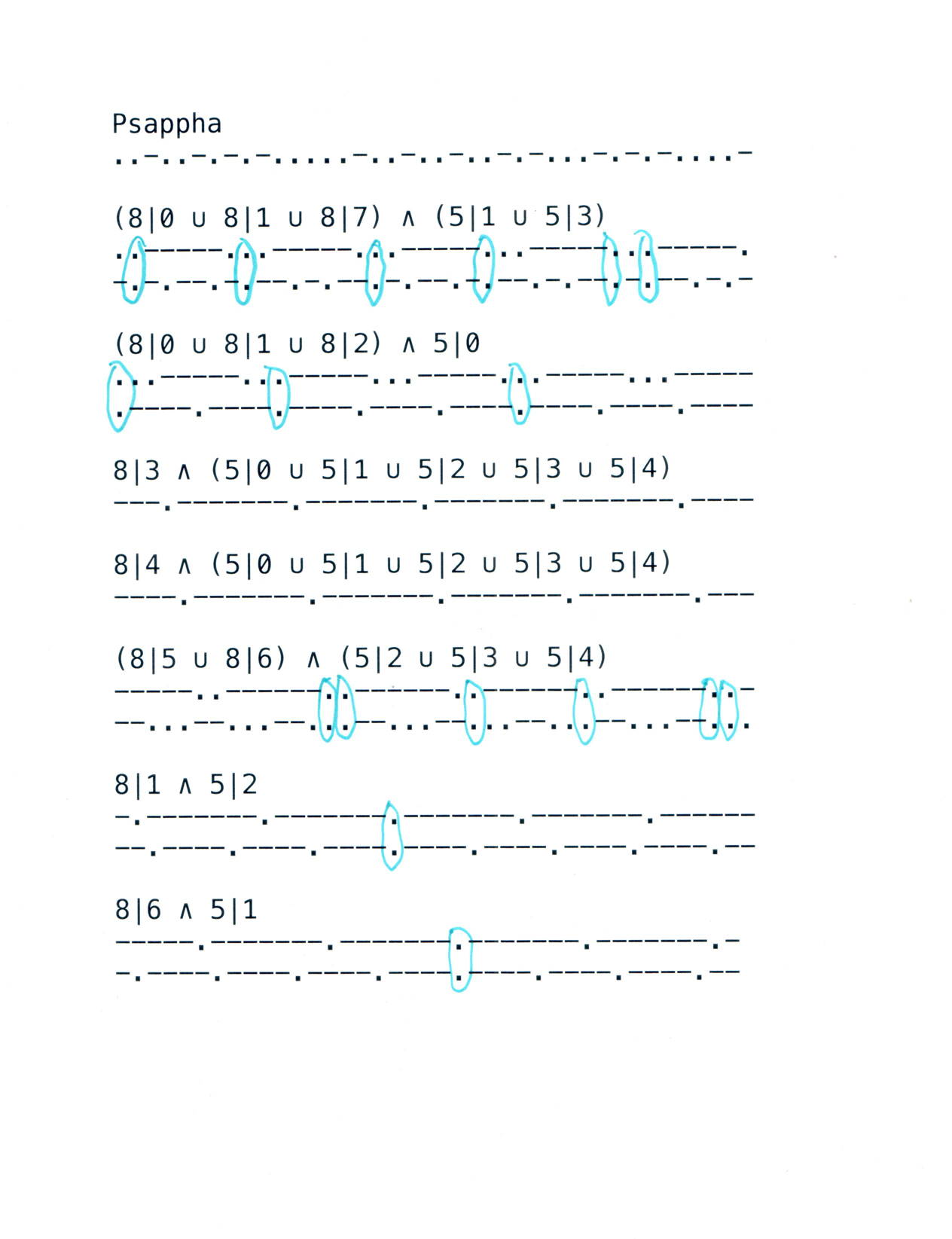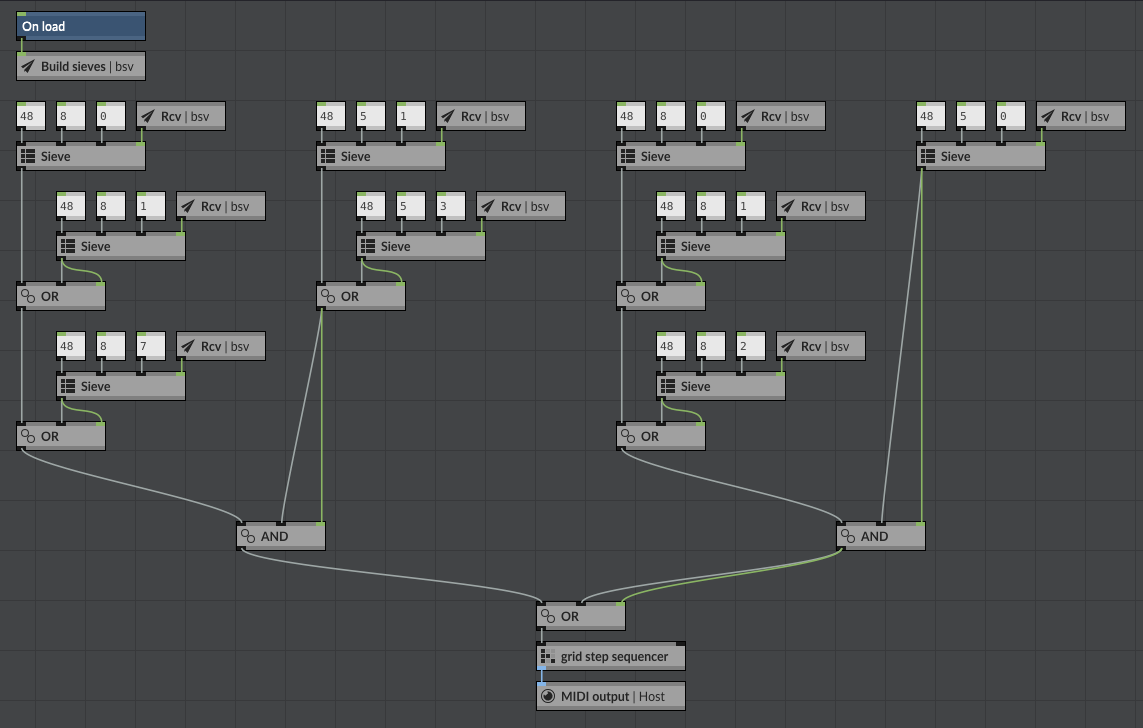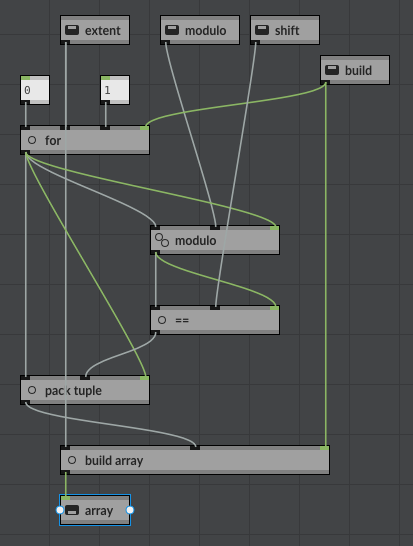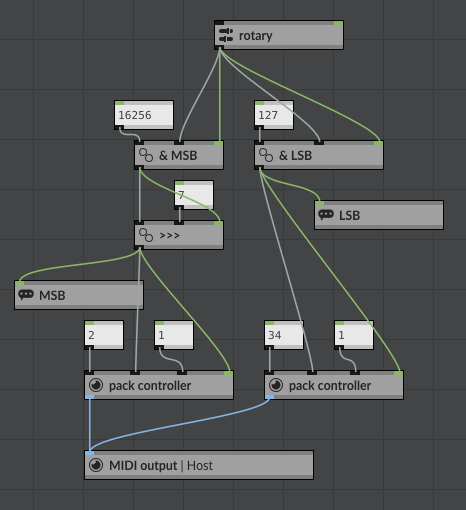Architect: Does anyone have a * macro/script
- KVRian
- 698 posts since 7 Dec, 2009 from GWB
If there’s a problem, then running the cable from the output of [==] should do the trick.
Last edited by cturner on Mon Feb 04, 2019 12:47 am, edited 1 time in total.
- KVRist
- 123 posts since 25 Jul, 2004 from Italy
Yes, I think this would "disambiguate" the order of execution. But still I'd like a word from Colin on this specific topic..
- KVRAF
- 6305 posts since 9 Dec, 2008 from Berlin
But then you would have the wrong value, wouldn't you?
Cheers,
Tom
Cheers,
Tom
"Out beyond the ideas of wrongdoing and rightdoing, there is a field. I’ll meet you there." - Rumi
ScreenDream Instagram Mastodon
ScreenDream Instagram Mastodon
- KVRian
- 698 posts since 7 Dec, 2009 from GWB
Yes, you’re absolutely correct. I shouldn’t answer these kinds of questions from my phone when I’m out on the street. :-(ThomasHelzle wrote: ↑Sun Feb 03, 2019 9:19 pm But then you would have the wrong value, wouldn't you?
-
- KVRist
- 140 posts since 11 Mar, 2014
Generative Midi Machine UPDATE:
Added Alberto's a-chaos algorithms:
a-clifford
a-dejong
a-duffing
a-henon
a-hopalong
a-logistic
a-lorenz
You can now choose for each track which algorithms for the notes and velocity. Feedback is welcome!
Special thanks to AlbertoZ for graciously providing the a-chaos algos!
viewtopic.php?p=7299827#p7299827
Special thanks to Charles Turner for graciously providing the logistic algo!
viewtopic.php?p=7284039#p7284039
Enjoy!
Added Alberto's a-chaos algorithms:
a-clifford
a-dejong
a-duffing
a-henon
a-hopalong
a-logistic
a-lorenz
You can now choose for each track which algorithms for the notes and velocity. Feedback is welcome!
Special thanks to AlbertoZ for graciously providing the a-chaos algos!
viewtopic.php?p=7299827#p7299827
Special thanks to Charles Turner for graciously providing the logistic algo!
viewtopic.php?p=7284039#p7284039
Enjoy!
You do not have the required permissions to view the files attached to this post.
- KVRist
- 123 posts since 25 Jul, 2004 from Italy
-
- KVRist
- 140 posts since 11 Mar, 2014
Generative MIDI Machine UPDATE:
Fixed: Track on/off.
Fixed: Scales drop-down was reporting incorrectly.
Added: Randomize scale & tonic button.
Added: Note duration. Finally got around to doing note duration rather than relying on the Hold module. Hold on/off button is still there to provide some random staccato. With the addition of note duration,
everything is smoother and less choppy. There are some extraneous notes (it seems) getting through sometimes. Will need to track that down.
Enjoy!
Fixed: Track on/off.
Fixed: Scales drop-down was reporting incorrectly.
Added: Randomize scale & tonic button.
Added: Note duration. Finally got around to doing note duration rather than relying on the Hold module. Hold on/off button is still there to provide some random staccato. With the addition of note duration,
everything is smoother and less choppy. There are some extraneous notes (it seems) getting through sometimes. Will need to track that down.
Enjoy!
You do not have the required permissions to view the files attached to this post.
Last edited by mannymang on Sat Feb 09, 2019 8:19 pm, edited 2 times in total.
-
- KVRAF
- Topic Starter
- 2681 posts since 25 Aug, 2003 from Bournemouth, UK
That's pretty incredible. Are there any debugging features I could implement that would help you track down these extra notes?
Architect, the modular MIDI toolkit, beta now available for macOS, Windows, and Linux.
-
- KVRist
- 140 posts since 11 Mar, 2014
Hi Colin, I'm pretty sure it's my multiple instances of metronomes where these extra signals are coming from. I need to go through it all with a fine toothed comb. I'll report back what I find. Thank you!
-
- KVRist
- 140 posts since 11 Mar, 2014
I think I figured it out, it's either 2 or more choices:colin@loomer wrote: ↑Thu Feb 07, 2019 2:54 pm That's pretty incredible. Are there any debugging features I could implement that would help you track down these extra notes?
a: The extra notes are coming from the aether where no amount of debugging will help.
b: When a duration of a note or notes are longer than the arrival of the succeeding note(s), the succeeding just need to be patient and wait their turn before making their debut thus surprising everyone with the unexpected appearance wherein the performance brings down the house.
c:
Happy accident, that can remain a feature, until later...
- KVRian
- 698 posts since 7 Dec, 2009 from GWB
Here's another installment of "something no one requested": "sieves" in Architect, used to generate attack time points for percussion, but obviously other things as well.
The "sieves" reference is to the Sieves of Eratothenes, which is a method of deriving prime numbers. They are put into the service of music, if not for the first time, certainly most extensively by Iannis Xenakis.
EDIT: If you wanted a general introduction to Xenakian sieves, I'd recommend a paper by my friend Dimitris Exarchos:
https://research.gold.ac.uk/15753/1/11. ... -Jones.pdf
There are a few generalizations of his work in code, but I believe they mostly deal with the generation of harmonic intervals, less so rhythm. I'd postponed fiddling with this for a long while, largely for lack of an inspiring platform on which to explore it. On offer are sketches really, but I imagine that bits could be adapted for service in many ways.
Here's video of Steve Schick performing Psappha, the first forty notes of which are roughly generated in Architect presets:
https://www.youtube.com/watch?v=Yge7GNl5p_k
You can download my files here:
http://vze26m98.net/loomer/psappha-1902 ... 190209.zip
There's a PDF in the ZIP archive that contains my notes, working backwards from a final product:

Sieves construct moduli that can be shifted along the set of integers, and as sets, they can be combined in basic ways: union, intersection and complementation. The above shows the finished forty-note line and the combination of moduli Xenakis used to produce it. The first combination: (8|0 u 8|1 u 8|7) V (5|1 u 5|3) is read as follows:
The union of moduli of 8, shifted by 0, 1 and 7 is shown in "dot form" on the top, the union of moduli of 5, shifted by 1 and 3 shown on the bottom. The intersection of these two 40 point lines are circled in blue.
The PDF works backward into this and into Ellen Rennie Flint's wonderful doctoral dissertation on Psappha. My notes as a whole are probably still rather cryptic, but I'd be happy to provide a copy of Flint's dissertation if you PM me.
I started work in Architect using visual objects, but as you can see from the next image, it really becomes quite large for the simplicity of work involved:

So I stopped after the first combination and moved to Lua. Given that the task is really one of pre-calculation, it's eminently suited for the job. The whole task collapsed into one visual object.
What's valuable about the first sketch is the sieve macro:

which in a simpler combination of moduli and the addition of knobs, could make a useful performance tool.
If you look at the page of moduli above, you'll see that Xenakis made things needlessly complex, such as the 8|3 intersection with the entire groups of 5-moduli. That's really just the 8|3 group; no need to do the intersection. I think the explanation is in his hand-calculation: with revision, it was always expensive to re-calculate. So the simple clean-up we are now able to do via computer just wasn't a part of his working method.
I hope this is of interest. Happy to talk further about it. Enjoy!
The "sieves" reference is to the Sieves of Eratothenes, which is a method of deriving prime numbers. They are put into the service of music, if not for the first time, certainly most extensively by Iannis Xenakis.
EDIT: If you wanted a general introduction to Xenakian sieves, I'd recommend a paper by my friend Dimitris Exarchos:
https://research.gold.ac.uk/15753/1/11. ... -Jones.pdf
There are a few generalizations of his work in code, but I believe they mostly deal with the generation of harmonic intervals, less so rhythm. I'd postponed fiddling with this for a long while, largely for lack of an inspiring platform on which to explore it. On offer are sketches really, but I imagine that bits could be adapted for service in many ways.
Here's video of Steve Schick performing Psappha, the first forty notes of which are roughly generated in Architect presets:
https://www.youtube.com/watch?v=Yge7GNl5p_k
You can download my files here:
http://vze26m98.net/loomer/psappha-1902 ... 190209.zip
There's a PDF in the ZIP archive that contains my notes, working backwards from a final product:

Sieves construct moduli that can be shifted along the set of integers, and as sets, they can be combined in basic ways: union, intersection and complementation. The above shows the finished forty-note line and the combination of moduli Xenakis used to produce it. The first combination: (8|0 u 8|1 u 8|7) V (5|1 u 5|3) is read as follows:
The union of moduli of 8, shifted by 0, 1 and 7 is shown in "dot form" on the top, the union of moduli of 5, shifted by 1 and 3 shown on the bottom. The intersection of these two 40 point lines are circled in blue.
The PDF works backward into this and into Ellen Rennie Flint's wonderful doctoral dissertation on Psappha. My notes as a whole are probably still rather cryptic, but I'd be happy to provide a copy of Flint's dissertation if you PM me.
I started work in Architect using visual objects, but as you can see from the next image, it really becomes quite large for the simplicity of work involved:

So I stopped after the first combination and moved to Lua. Given that the task is really one of pre-calculation, it's eminently suited for the job. The whole task collapsed into one visual object.
What's valuable about the first sketch is the sieve macro:

which in a simpler combination of moduli and the addition of knobs, could make a useful performance tool.
If you look at the page of moduli above, you'll see that Xenakis made things needlessly complex, such as the 8|3 intersection with the entire groups of 5-moduli. That's really just the 8|3 group; no need to do the intersection. I think the explanation is in his hand-calculation: with revision, it was always expensive to re-calculate. So the simple clean-up we are now able to do via computer just wasn't a part of his working method.
I hope this is of interest. Happy to talk further about it. Enjoy!
Last edited by cturner on Sat Feb 09, 2019 10:39 pm, edited 1 time in total.
- KVRist
- 123 posts since 25 Jul, 2004 from Italy
Veeeery interesting. I Have to dig into it. Thanks for sharing..
- KVRian
- 698 posts since 7 Dec, 2009 from GWB
- KVRian
- 698 posts since 7 Dec, 2009 from GWB
I haven't heard much talk recently about automation in Architect, but here's a first bit of a larger thing I'll post eventually: the processing required to convert a 14bit value into it's respective 7bit MSB/LSB CC message streams:
DL: http://vze26m98.net/loomer/cc_14bit-190 ... 90211.frag

Not elaborately tested, but seems to work a treat on the u-he synths that support 14bit CCs.
DL: http://vze26m98.net/loomer/cc_14bit-190 ... 90211.frag

Not elaborately tested, but seems to work a treat on the u-he synths that support 14bit CCs.



